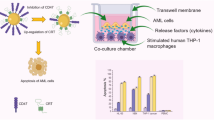Summary
Activated by interferon γ (IFNγ)(50 U/ml) and lipopolysaccharide (50 ng/ml), mouse peritoneal macrophages were cocultured with the L1210 parental cell line (L1210/PRT) and its Adriamycin-, cisplatin-resistant cell lines (L1210/ADM, L1210/CDDP) for 24 h at effector: target (E:T) ratios of 10:1, 5:1 and 2:1. The direct 3-(4,5-dimethylthiazol-2-yl)-2,5-diphenyltetrazolium-bromide (MTT)-cleavage assay, a new improved indirect MTT assay, and the colony-formation assay were used to quantify macrophage-mediated suppression of these non-adherent tumour targets. The results showed that the macrophages can produce formazan at a high level, which can interfere with the final results of a direct MTT assay. The new indirect MTT assay can avoid such interference because the effectors are separated from the targets before the assay is performed, so the real viability of the targets is reflected. An indirect MTT assay, as developed in this study, could be better than the direct assay for examining the suppressive effect of activated macrophages on non-adherent tumour cells in vitro. This study also revealed that all the L1210 cell lines can be suppressed significantly by the macrophages at E:T ratios of 10:1 and 5:1 while the two drug-resistant cell lines have lower survival rates at an E:T ratio of 10:1, indicating that they are more susceptible than their parental cell line.
Similar content being viewed by others
References
Dumont S, Hartmann D, Poindron P, Oberling F, Faradji A, Bartholeyns J (1985) Control of antitumoral activity of human macrophages produced in large amounts in view of adoptive transfer. Eur J Cancer Clin Oncol 24: 1691
Ferrari M, Fornasiero MC, Isetta AM (1990) MTT colorimetric assay for testing macrophage cytotoxic activity in vitro. J Immunol Methods 131: 165
Fidler IJ (1974) Inhibition of pulmonary metastasis by intravenous injection of specifically activated macrophages. Cancer Res 34: 1074
Fogler WE, Fidler IJ (1985) Nonselective destruction of murine neoplastic cells by syngeneic tumoricidal macrophages. Cancer Res 45: 14
Gerlier D, Thomasset N (1986) Use of MTT colorimetric assay to measure cell activation. J Immunol Methods 94: 57
de Halleux F, Taper HS, Deckers C (1973) A simple procedure for identification of macrophages in peritoneal exudates. Br J Exp Pathol 54: 352
Hamburger A, Salmon SE (1977) Primary bioassay of human myeloma stem cells. J Clin Invest 60: 846
Koestler TP, Johnson WJ, Rieman D, Dalton BJ, Greig RG, Poste G (1987) Differential expression of murine macrophage-mediated tumor cytotoxicity induced by interferons. Cancer Res 47: 2804
Liotta LA, Gattozzi C, Kleinerman J (1977) Reduction of tumor cell entry into vessels by BCG-activated macrophages. Br J Cancer 36: 639
Mosmann T (1983) Rapid colorimetric assay for cellular growth and survival: application to proliferation and cytotoxicity assays. J Immunol Methods 65: 55
Piessens WF, Churchill WH, David J (1975) Macrophages activated in vitro with lymphocyte mediators kill neoplastic but not normal cells. J Immunol 114: 293
Salmon SE (1980) Morphologic studies of tumor colonies: In: Salmon SE (ed) Cloning of human tumor stem cells. Liss, New York, p 135
Author information
Authors and Affiliations
Additional information
Supported by grants from the Ministry of Health and Welfare and the Ministry of Education, Science and Culture, Japan
Rights and permissions
About this article
Cite this article
Jiao, H., Shen, W., Ohe, Y. et al. A new 3-(4,5-dimethylthiazol-2-yl)-2,5-diphenyltetrazolium bromide(MTT) assay for testing macrophage cytotoxicity to L1210 and its drug-resistant cell lines in vitro. Cancer Immunol Immunother 35, 412–416 (1992). https://doi.org/10.1007/BF01789020
Received:
Accepted:
Issue Date:
DOI: https://doi.org/10.1007/BF01789020




